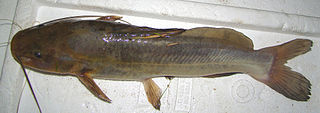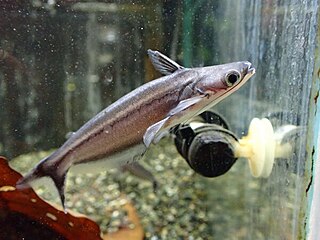
Ancistrus is a genus of nocturnal freshwater fish in the family Loricariidae of order Siluriformes, native to freshwater habitats in South America and Panama. Fish of this genus are common in the aquarium trade where they are known as bushynose or bristlenose catfish. In the aquarium hobby they are often referred to as bushynose or bristlenose plecos instead, but this may lead to confusion as "pleco" usually is used for Hypostomus plecostomus and its allies and is often used as a catchall term for any loricariids remotely resembling that species.

Astyanax is a genus of freshwater fish in the family Characidae of the order Characiformes. Some of these fish, like many of their relatives, are kept as aquarium pets and known collectively as tetras. With around 150 described species and new ones being described yearly, this genus is among the largest of the entire order; Hyphessobrycon also has more than 145 species and which one is larger at any one time depends on whether more species have been recently described in one or the other. The blind and colorless cave tetra of Mexico is a famous member of the genus, but its taxonomic position is disputed: Some recognize it as part of the Mexican tetra and this is supported by phylogenetic evidence, but others recognize the cave form as a separate species, A. jordani.

Leporinus is a genus of fish in the family Anostomidae native to South America. The fossil species Leporinus scalabrinii, known from the late Miocene of Entre Ríos in Argentina, has only recently been added to this genus after being misidentified as a species of primate under the name Arrhinolemur scalabrinii for over 100 years.

The Pimelodidae, commonly known as the long-whiskered catfishes, are a family of catfishes.

Astroblepus is a genus of fish in the family Astroblepidae found in South America and Panama. This genus is the only member of its family. These catfishes are primarily found in torrential streams in the Andean area. Astroblepus pholeter and A. riberae are troglobites adapted to living in subterranean water systems. These species are typically small, less than 10 cm (4 in). The largest species reaches 30 cm (1 ft). These fish have suckermouths like those of loricariids. They have two pairs of barbels, maxillary and nasal. The dorsal fin spine lacks a locking mechanism. These fish also have odontodes, tiny teeth on their skin. All species exhibit a conical, pointy type on their fin rays like that found in other loricarioids; other species also exhibit a blunt type that is only found on their skin.

Peckoltia is a genus of small South American armored suckermouth catfishes. Many of these fish are popular aquarium fish.

The firewood catfish a species of South American pimelodid catfish, is the sole member of the genus Sorubimichthys. Known by locals along the Amazon Basin as peixe-lenha, the firewood catfish is so called because it is of little eating value and is often dried and used for firewood.
Duopalatinus is a small genus of long-whiskered catfishes native to South America.

Doras is a genus of thorny catfishes native to tropical South America.

Pimelodus is a genus of fish in the family Pimelodidae native to Central and South America.
Hisonotus is a genus of armored catfishes native to South America. Species of Hisonotus and Curculionichthys are the only representatives of the subfamily Otothyrinae having serrae on the posterior edge of the pectoral fin spine. These species are small fishes, generally found in small fast flowing streams, where they grasp to the branches and leaves of aquatic or subaquatic plants. The species of this genus mostly occur in Atlantic coastal streams of southern Brazil and the Paraguay-Paraná system of southern South America. They are also distributed in the Río de La Plata basin and coastal rivers of southeastern Brazil.

Pimelodella is a genus of three-barbeled catfishes.

Rhamdia is a genus of three-barbeled catfishes found in Mexico, Central and South America. These catfishes are nocturnal, opportunistic carnivores, found in a wide range of freshwater habitats. This genus includes a number of troglobitic members, encompassing a number of taxa, including R. enfurnada, R. guasarensis, R. laluchensis, R. laticauda, R. macuspanensis, R. quelen, R. reddelli and R. zongolicensis. In a few of these only some of their populations are troglobitic.

Auchenipterus is a genus of driftwood catfishes.

Chaetostoma, also known as the bristlemouth catfish, is a genus of suckermouth armored catfishes native to South America with one species, C. fischeri, extending into Panama. Most species inhabit flowing rivers in the lower Andes and its foothills. Some species are kept in unheated aquaria.
Sternarchella, the bulldog knifefish, is a genus of ghost knifefishes found at depths of 2–50 m (7–164 ft) in the main channel of large rivers in South America. Most are from the Amazon basin, but S. orthos is found both in the Amazon and Orinoco, S. orinoco is restricted to the Orinoco and S. curvioperculata restricted to the upper Paraná basin. They are often common in their habitat.
Myoglanis is a genus of three-barbeled catfishes native to tropical South America.
Priapichthys is a genus of poeciliid fishes native to Costa Rica, Panama and Colombia.

Geophagini is a tribe of cichlids from the subfamily Cichlinae, the American cichlids. It is the sister taxon to the clade which includes the Cichlasomatini and Heroini. Fishes in the Geophagini are distributed from Panama south to Argentina, it is the most speciose of the seven tribes within the Cichlinae and it is subdivided into three sub-tribes, Acarichthyina, Crenicaratina, and Geophagina which together contain over 200 species. Geophagines show morphological and behavioural specialisations to enable them to sift the substrates within their mouths so that they can separate benthic invertebrates from substrates dominated by sand or silt.
Caiman australis is an extinct species of caiman described in 1858 on the basis of a left maxilla that was collected from the Upper Miocene age Ituzaingó Formation of Entre Rios, Argentina.














